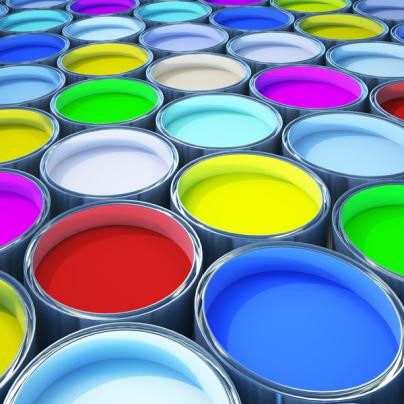1. Hyperbranched system
As a new type of polymer, hyperbranched polymer has a spherical structure, a large number of active end groups and no winding between molecular chains. Hyperbranched polymers have the advantages of easy dissolution, low melting point, low viscosity and high reactivity. Therefore, acryloyl groups and hydrophilic groups can be introduced to synthesize waterborne light curing oligomers, which opens up a new way for the preparation of Waterborne UV resin.
A UV curable waterborne hyperbranched polyester (whpua) was prepared by the reaction of Hyperbranched Polyester rich in hydroxyl groups with succinic anhydride and ipdi-hea prepolymer, and finally neutralized with organic amine to form salt. The results show that the light curing rate of the resin is rapid and the physical properties are good. With the increase of hard segment content, the glass transition temperature of the resin increases, the hardness and tensile strength also increase, but the elongation at break decreases. Hyperbranched polyesters were prepared from polyanhydrides and monofunctional epoxides. Glycidyl methacrylate was introduced to further react with hydroxyl and carboxyl groups of hyperbranched polymers. Finally, triethylamine was added to neutralize and form salts to obtain UV curable waterborne hyperbranched polyesters. The results showed that the more the carboxyl group content in the end of the water-based hyperbranched resin, the better the water solubility; The curing rate of the resin increases with the increase of terminal double bonds.
2 organic-inorganic hybrid system
Waterborne UV light cured organic / inorganic hybrid system is an effective composite of Waterborne UV resin and inorganic materials. The advantages of inorganic materials such as high wear resistance and high weather resistance are introduced into the resin to improve the comprehensive properties of the cured film. By introducing inorganic particles such as nano-SiO2 or montmorillonite into the UV curing system through direct dispersion method, sol-gel method or intercalation method, the UV curing organic / inorganic hybrid system can be prepared. In addition, the organosilicon monomer can be introduced into the molecular chain of aqueous UV oligomer.
Organo / inorganic hybrid lotion (Si PUA) was prepared by introducing polysiloxane groups into the soft segment of polyurethane with two terminal hydroxybutyl polydimethylsiloxane (PDMS) and diluting with acrylic monomers. After curing, the paint film has good physical properties, high contact angle and water resistance. Hyperbranched hybrid polyurethane and light cured hyperbranched polyurethane were prepared from self-made polyhydroxy hyperbranched polyurethane, succinic anhydride, silane coupling agent KH560, glycidyl methacrylate (GMA) and hydroxyethyl methacrylate. Then, Si02 / Ti02 organic-inorganic hybrid sol of light cured hyperbranched polyurethane was prepared by blending and hydrolyzing with tetraethyl orthosilicate and n-butyl titanate in different proportions. The results show that with the increase of inorganic content, the pendulum hardness of hybrid coating increases and the surface roughness increases. The surface quality of SiO2 hybrid coating is better than that of Ti02 hybrid coating.
3 dual curing system
In order to solve the shortcomings of three-dimensional curing of Waterborne UV resin and curing of thick coating and colored system, and improve the comprehensive properties of the film, researchers developed a dual curing system combining light curing with other curing systems. At present, light curing, thermal curing, light curing / redox curing, free radical light curing / cationic light curing and light curing / wet curing are common dual curing systems, and some systems have been applied. For example, UV electronic protective adhesive is a dual curing system of light curing / redox or light curing / wet curing.
The functional monomer ethyl acetoacetate methacrylate (amme) was introduced into polyacrylic acid lotion, and the light curing group was introduced through Michael addition reaction at low temperature to synthesize heat curing /uv curing waterborne polyacrylate. Dry at a constant temperature of 60 ° C, 2 x 5 Under the condition of 6 kW high-pressure mercury lamp irradiation, the hardness of the resin after film formation is 3h, the alcohol resistance is 158 times, and the alkali resistance is 24 hours.
4 epoxy acrylate / polyurethane acrylate composite system
Epoxy acrylate coating has the advantages of high hardness, good adhesion, high gloss and good chemical resistance, but it has poor flexibility and brittleness. Waterborne polyurethane acrylate has the characteristics of good wear resistance and flexibility, but poor weather resistance. Using chemical modification, physical blending or hybrid methods to effectively compound the two resins can improve the performance of a single resin and give full play to their advantages, so as to develop a high-performance UV curing system with both advantages.
5 macromolecular or polymerizable photoinitiator
Most photoinitiators are aryl alkyl ketone small molecules, which cannot be completely decomposed after light curing. The residual small molecules or photolysis products will migrate to the coating surface, causing yellowing or odor, which will affect the performance and application of the cured film. By introducing photoinitiators, acryloyl groups and hydrophilic groups into hyperbranched polymers, researchers synthesized waterborne macromolecular polymerizable photoinitiators to overcome the disadvantages of small molecular photoinitiators.
Post time: May-09-2022













